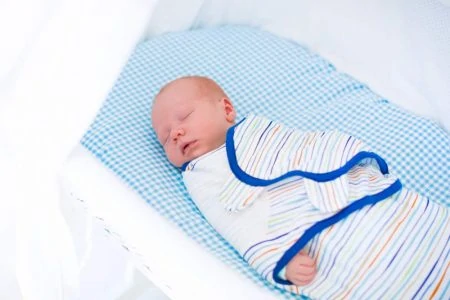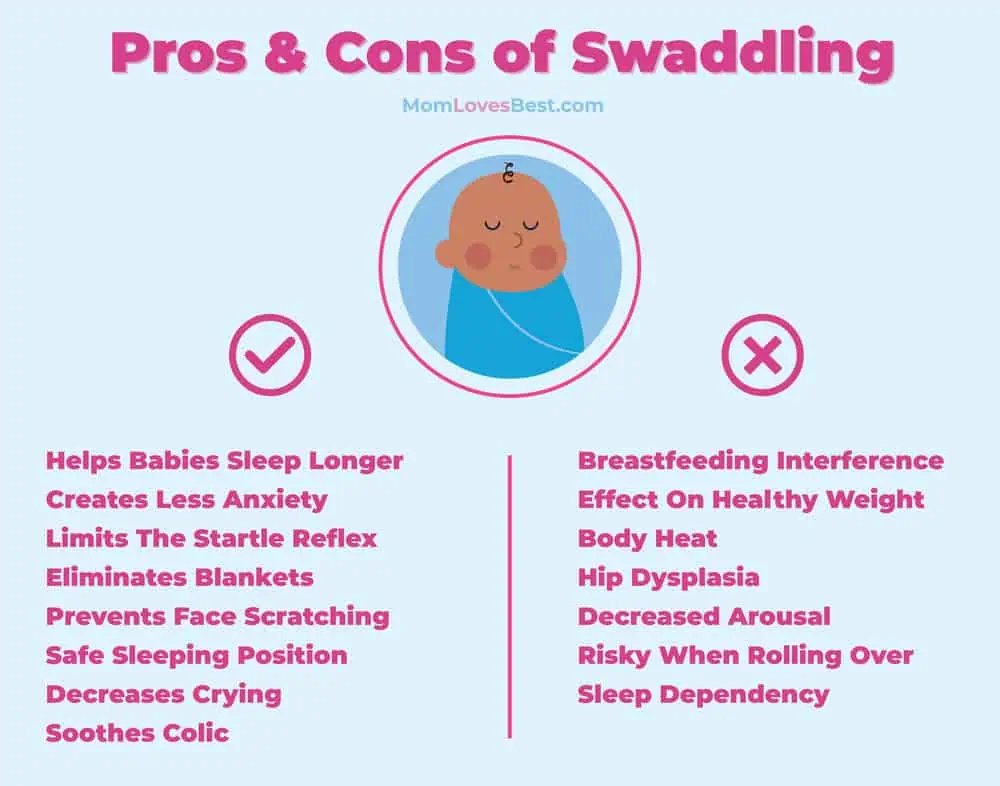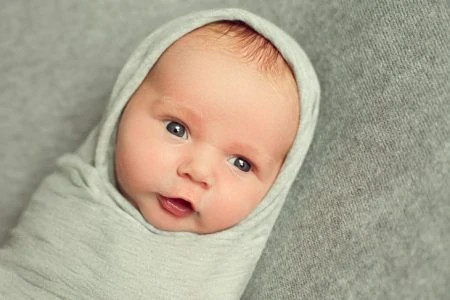Do you swaddle your baby, or are you wondering if you should? Some people claim that swaddling is a lifesaver and every parent should try it, while others believe it to be a harmful practice.
So, who do you believe? Is swaddling safe?
Swaddling is a popular practice, but many parents don’t take the time to research the topic.
We’ve created this guide to make the process easy for you and answer all your questions. We’ll discuss the benefits and risks of swaddling and give you our top tips for safe swaddling.
Key Takeaways
- Swaddling helps babies sleep longer, reduces anxiety, and prevents face scratching.
- Risks include overheating, hip dysplasia, and decreased arousal, which may increase the risk of SIDS.
- To swaddle safely, don’t over-swaddle, ensure a secure swaddle, and avoid swaddling too tightly.
- Stop swaddling before the baby starts to roll over (around 2 months of age) to avoid suffocation risks.
Why Do Babies Like Swaddling?
Your newborn baby is not quite used to this outside world yet, and a swaddle can remind them of the time in their mommy’s womb. Most babies are comforted by swaddling because it is similar to the security they experienced before birth.
Many parents choose to swaddle if their baby has a strong startle reflex that often wakes them. Swaddling also helps to calm fussy babies.
Age Recommendation
Benefits of Swaddling
Swaddling is a popular technique that has, in many ways, proven to be effective. There is an entire market for swaddle blankets and items to help you wrap your baby to make them feel safe and comforted.
Swaddling is so popular because it has many benefits (1):
- Helps babies sleep longer: Your baby will feel more secure, like being held close to their mom. The swaddle helps your baby feel contained in an enclosed environment when they stir, which helps lull them back to sleep.
- Reduces anxiety: The extra weight applied by the swaddle can somewhat resemble being held, which has a calming effect and helps your baby relax.
- Limits the startle reflex: Your baby doesn’t quite have motor controls figured out yet. This means they could be sleeping one minute and then experience a jerking motion the next. Whether your baby jerks an arm or leg, it’s enough to wake them up from even a deep sleep. The gentle pressure from swaddling helps contain their extremities, keeping unexpected movements to a minimum.
- Eliminates blankets: Many parents want to ensure their baby is as comfortable as possible. But a blanket, while it might seem comforting, can pose a serious suffocation threat for your baby, so a swaddle is a great alternative. The swaddle keeps your baby warm but should never cover your baby’s face.
- Prevents face scratching: Your baby will have fingernails like little razors that always seem to make their way to the face. Many babies scratch themselves in their sleep — so much that you may notice dried blood on their face the next day. A safe swaddle keeps the arms secure, preventing face scratching.
- Maintains a safe sleeping position: A swaddle helps keep your baby on their back (until they learn how to roll over), which is the safest sleeping position. Not only does it keep your baby comforted while in the best position for sleep, but a swaddle reminds an overtired parent to lay their baby on their back.
- Decreases crying: If your baby seems never to be pleased no matter what you do, swaddling may be your answer. In babies 8 weeks old or younger, it can potentially decrease crying by 42%. Swaddling may be the key to some relief.
- Soothes colic: Parents who have babies with colic often resort to a swaddle. The extra comfort and security of a swaddle, along with other calming measures, has been known to soothe a colicky baby.
Swaddling Risks
Like most things in life, even something as simple as swaddling has risks. Some are much more severe than others, but it’s best to know what to look for and what to avoid (2).
- Breastfeeding interference: Immediately swaddling after birth has been shown to make breastfeeding a little more challenging. Babies who rack up more skin-to-skin time with their mom shortly after birth tend to take to the breast more often. You can address this easily if you voice your opinions to the hospital regarding immediate swaddling. Keeping your baby warm is essential, but a simple blanket over mom while snuggling with baby will suffice in those early days.
- Effect on healthy weight: The delay with breastfeeding in swaddled infants could be why some babies don’t put on enough weight at first. Many believe that infants need touch to thrive, and a swaddled baby is not receiving that vital skin-to-skin touch, so choose to limit swaddling a bit in the beginning.
- Body heat: Swaddling with a warm blanket can cause your baby to overheat. You can dress your baby in light clothing or choose a swaddle that consists of light cotton or similar materials.
- Hip dysplasia: The position required for swaddling causes your baby’s hips and knees to be fully extended in an unnatural position. This can lead to hip dysplasia or dislocation of the hips. By choosing blankets specifically designed for swaddling and making sure they aren’t too tight over the legs, you can limit the chances your baby will develop this condition. If your baby was born with hip dysplasia, avoid swaddling altogether.
- Decreased arousal: Parents prefer swaddling because it helps keep their baby asleep longer, but it can also cause babies to have decreased arousal, making them slow to wake up. Some studies show that decreased arousal may increase the risk of SIDS (3).
- Risky when rolling over: If a swaddled baby rolls over to sleep on their stomach, they are at risk of suffocation. All sources say to discontinue swaddling when babies show signs of learning to roll over (4).
- Sleep dependency: If used long enough, your baby may grow accustomed to being swaddled before bedtime. You could view this as a habit your baby requires to fall asleep. This isn’t a bad thing, but it can create some difficulty, as your baby will eventually need to wean off of the swaddle.
Safe Swaddling Tips
Parents use swaddling as a way to soothe and comfort their baby, but there are potential risks when done incorrectly.
Here are some tips parents can follow to help ensure safe swaddling.
- Don’t over-swaddle: Some parents want to make sure their baby is warm, and this can cause overheating. A very young baby isn’t quite able to regulate their temperature yet, but this doesn’t mean you have to keep them excessively warm — overheating can increase the risk of SIDS (Sudden Infant Death Syndrome). Signs of overheating include damp hair and red cheeks. You should only dress your baby in one layer more than what you are wearing.
- Secure swaddle: Ensure the swaddle is secure. Whether you use a blanket designed for swaddling or swaddle your baby with a regular blanket, it needs to be secure. If the swaddle can come undone, it can potentially make its way over your baby’s face and cover their nose or mouth while they sleep.
- Not too tight: A swaddle that is too tight can lead to joint problems. Some studies show that a tight swaddle may hinder lung function because it limits the oxygen your baby’s small lungs can hold (5). Experts recommend you use a blanket designed for swaddling, rather than a typical blanket. Swaddling blankets exist to ensure proper mobility when swaddled.
- Stop at the roll: Before your baby learns to roll over, you should stop swaddling. A swaddled baby sleeping on their stomach creates an increased risk of suffocation.
- Know the limits: Your baby may prefer to be swaddled, but you shouldn’t wrap them all day. Your baby needs time to learn how to move around, learn where their body parts are, and utilize their mobility and freedom.
- Ask for help: It’s important to make sure you learn how to swaddle safely. You should have someone teach you the proper swaddling technique at your birthing location. A safe swaddle is key to avoiding potential risks.
Not all babies enjoy being swaddled, and this is completely normal. You shouldn’t force your baby into the swaddling position if it’s not comforting. If your baby doesn’t like their arms being enclosed, you can still swaddle them with their arms out.
Swaddling is popular when babies are in the newborn stage. Babies will generally begin to dislike being swaddled by 4 months of age, some much sooner. Most experts recommend stopping swaddling well before your baby starts to roll over, at around 2 months of age (6).
FAQs
The Bottom Line
You can avoid most swaddling risks if you do it correctly. Make sure the swaddle is not too tight, and your baby can move and bend their legs freely. A swaddle is supposed to be tight enough that it doesn’t come undone while sleeping, but it shouldn’t limit your baby’s range of motion completely, especially in the legs and hips.
Swaddling tends to cause a baby to overheat, so make sure you don’t over-swaddle your baby. Incorporate skin-to-skin time and time for your baby to move around freely.
Use swaddling sparingly so it doesn’t become a requirement for your baby to fall asleep, and discontinue the practice before 2 months of age or just before they begin to roll over.







